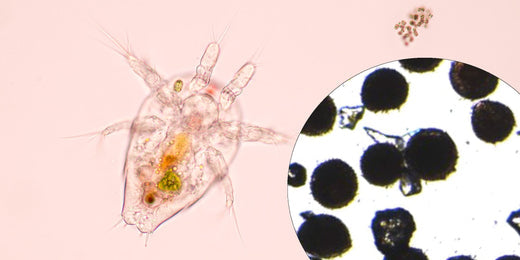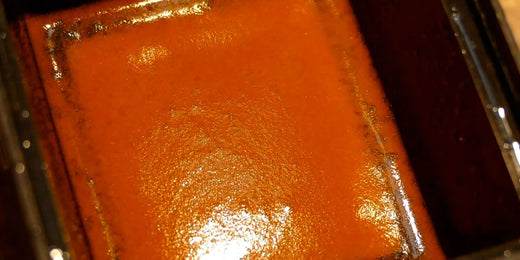Copepods - high-quality live food
Copepods or copepods of the species Acartia tonsa are THE superfood for rearing fish, crab, shrimp and jellyfish larvae. Their particularly high nutrient content makes them a popular live food. Thanks to blue biotechnology, it is now possible to breed the marine plankton species Acartia tonsa on land in a controlled manner and buy the copepod eggs in a salt solution. We are very enthusiastic about the success of the breeding process and have therefore created a step-by-step guide.
Hatching instructions for copepod eggs of Acartia tonsa
Similar to the hatching of Artemia eggs, we suggest the following procedure:
1. prepare seawater
Incubate copepod eggs in freshly prepared seawater. The water should be sterilised beforehand and contain 30 to 35 g/l salt. It is best to prepare the salt water solution with boiled tap water or osmosis water. It is best to use aquarium sea salt from a specialist.
2. container and ventilation
As an incubator, we recommend the design that is also used for hatching Artemia eggs. This means a cylindrical container that tapers towards the bottom (e.g. an inverted PET bottle with an open base). An aeration tube is placed at the bottom of the container to ensure homogeneous mixing. The aeration tube should have a diameter of 6 to 8 mm. The aeration should be relatively coarse bubbling and not very intensive (approx. 3-5 bubbles/sec.). It is important that the copepod eggs remain evenly mixed and cannot sediment anywhere, otherwise the hatching rate will be reduced. The oxygen concentration should be above 6 mg/litre. If, on the other hand, the bubbles are too fine using a wooden diffuser, the eggs may be skimmed off and the newly hatched nauplii discharged.
3. dosing of the eggs
Shake the bottle vigorously before dosing. Use 20,000 copepod eggs per litre of seawater. 20,000 eggs correspond to 2 ml of mixed solution (dosing spoon is included with algova products).
For experienced breeders, the dosage can be increased to 40,000 copepod eggs per litre. The hatching rate can vary depending on the storage conditions, age of the eggs and hatching method, but is usually between 70-90 % in the first two months after purchase (after that the hatching rate decreases slightly).
4. temperature
The optimum breeding temperature for the copepod species Acartia tonsa is between 20 and 25°C. The temperature of 25°C should not be exceeded.
5. pH value
The optimum pH value should be between 8.0 and 8.3. Freshly prepared seawater normally has a pH value of 8.2 at 30 g/l. The pH value can be readjusted or stabilised by adding sodium hydrogen carbonate (known as bicarbonate or Kaiser Natron). However, a dosage of 1 g/l should not be exceeded.
6. lighting
The incubator should ideally be indirectly illuminated with natural daylight. Avoid direct sunlight, otherwise the container will heat up excessively. Alternatively, artificial lighting is also possible, but this should be set with a timer according to the daily cycle (12 h on/12 h off).
7. hatching and observation
Hatching takes place in the time range from 48 h to 72 h after the start of incubation. Most nauplii hatch in this time range. The time it takes for the first nauplii to hatch depends on the lighting and temperature. The copepod nauplii of Acartia tonsa hatch at a size of 70-110 µm. They are just visible to the eye in a glass container in front of a strong light source. Alternatively, they can be observed very well under a binocular.
8. feeding
The freshly hatched nauplii should be fed as quickly as possible or kept in a cool place at 10°C. After 24 hours at 25 °C, the nauplii have already lost most of their nutritional value. Carefully filter the brood solution through a zooplankton sieve with a 50 µm mesh size and then use the nauplii immediately to feed the larvae or rinse them off the gauze with water from the larval container or aquarium.
9. breeding of Acartia tonsa
If the nauplii are to grow into copepods, they must be fed with high-quality microalgae . We recommend Rhodomonas or Isochrysis for this. These are the only microalgae that stimulate female copepods to produce and lay eggs. The algae Isochrysis is contained in the product RotiBomb from algova , for example, which experience has shown is also suitable for the further breeding of copepods. To do this, add a little algae/powder to the seawater every day so that the water is just slightly yellowish/greenish. Typical development of Acartia tonsa nauplii:
Day 1-2: Nauplii 70-110 µm
Day 10-14: Adult animals 650-800 µm
Day 14-80: Adult animals grow to a maximum of 1200 µm
For further growth of the culture, we recommend increasing the amount of culture water by about 50% daily from day 3 to day 10 (example: if starting with 10,000 eggs in 500 ml seawater, the amount of seawater should be 2.5 litres on day 5 and 13 litres on day 10).
You have made suggestions for optimisation or had special experiences. We are very grateful for any feedback .




